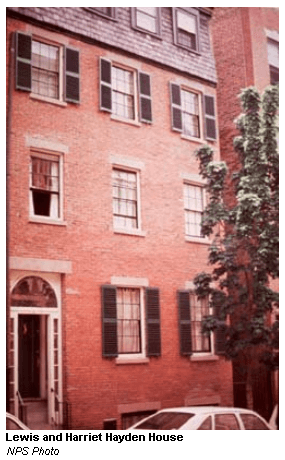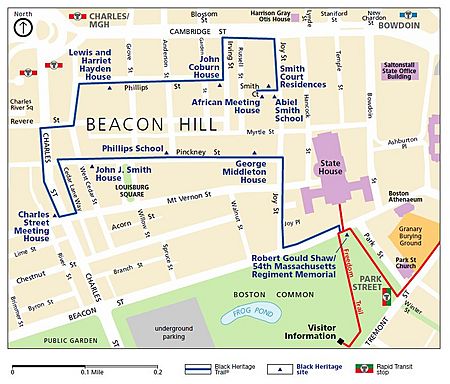Lewis and Harriet Hayden House facts for kids
Quick facts for kids Lewis and Harriet Hayden House |
|
|---|---|

Lewis and Harriet Hayden House, former home of African American abolitionists.
|
|
| General information | |
| Location | Beacon Hill |
| Address | Private residence: 66 Phillips Street |
| Town or city | Boston |
| Country | United States |
| Coordinates | 42°21′37″N 71°04′09″W / 42.360239°N 71.069036°W |
The Lewis and Harriet Hayden House was once the home of Lewis Hayden and Harriet Hayden. They were an African-American couple who bravely escaped slavery in Kentucky. Their house, located in Beacon Hill, Boston, was a secret stop on the Underground Railroad. This was a network of safe houses that helped enslaved people find freedom.
Famous author Harriet Beecher Stowe even visited the Haydens' home. She was doing research for her famous book, Uncle Tom's Cabin (published in 1852). Lewis Hayden was a very important leader in Boston's African-American community. He spoke out against slavery and was part of the Boston Vigilance Committee. This group worked to protect escaped slaves from the strict Fugitive Slave Act of 1850.
Contents
The Haydens' Journey to Freedom
Lewis Hayden was born into slavery in Lexington, Kentucky in 1812. His first wife and their son were sold away from him. They were sent to the Deep South, and Lewis never saw them again.
Lewis later married Harriet Bell, who had a son named Joseph. In 1844, with help from people who opposed slavery, they escaped. They traveled through Ohio and then along the Underground Railroad to Canada.
A Brave Helper: Delia Ann Webster
An abolitionist named Delia Ann Webster helped the family of three escape. She was a school teacher from Vermont who had moved to Kentucky. She was caught when she returned from helping the Haydens. Delia was jailed, tried, and sentenced to years in the Kentucky Penitentiary.
However, she somehow received a pardon from the Governor and was released. Delia Ann Webster continued her work and was jailed several more times for helping enslaved people.
Settling in Boston
In 1845, the Haydens returned to the United States in Detroit. By January 1846, they had moved to Boston. Lewis Hayden opened and managed a clothing store on Cambridge Street.
Around 1849 or 1850, the Haydens moved into the house at 66 Phillips Street. This street was then called Southac Street. In 1853, Francis Jackson, a member of the anti-slavery Boston Vigilance Committee, bought the house. It is believed he did this to protect Hayden's work with the Underground Railroad.
A Safe Haven for Freedom Seekers
The Haydens regularly welcomed and cared for African Americans who had escaped slavery. Their home served as a boarding house, offering a safe place to stay. Famous freedom seekers like Ellen and William Craft found shelter there.
Lewis Hayden once stopped slave catchers from taking the Crafts. He threatened to blow up his home with gunpowder if they tried to reclaim them. Records from the Boston Vigilance Committee show that many people received help and safe shelter at the Hayden home between 1850 and 1860.
Harriet Beecher Stowe's Visit
In 1853, Harriet Beecher Stowe visited the Haydens' home. She was gathering facts for her book, A Key to Uncle Tom's Cabin. An eyewitness described how thirteen newly escaped slaves were brought into one room for her to see.
Even though Mrs. Stowe had written Uncle Tom's Cabin to show the harshness of the Fugitive Slave Act, she had never seen so many "fugitives" together before. This visit helped her understand their experiences even more.
Lewis Hayden's Fight for Justice
Lewis Hayden was a key figure in many efforts to resist slavery.
- He helped rescue Shadrach Minkins from federal custody in 1851.
- He played a big part in the attempt to rescue Anthony Burns.
- Hayden also gave money to John Brown, who planned a raid on Harper's Ferry.
- He helped recruit soldiers for the 54th Regiment, a famous African-American Union Army unit.
Sadly, Lewis and Harriet's son served in the Union Navy during the Civil War and was killed. In 1865, Harriet Hayden bought the house from Francis Jackson's estate.
Lewis Hayden continued to serve his community after the war. He was a member of the Massachusetts House of Representatives in 1873. He also worked for the Massachusetts Secretary of State from 1859 until his death in 1889.
Harriet Hayden passed away in 1893. In her will, she left money to create a scholarship at Harvard Medical School. This scholarship was specifically for African American students.
A Hub of Abolitionist Activity
The Haydens' house was a very important meeting place for abolitionists. Benjamin Quarles, in his book The Negro in the Civil War, wrote about the house:
- It was where Theodore Parker, a famous abolitionist, married the escaped slaves Ellen and William Craft.
- John Brown stayed there during his last trip to Boston.
- Hayden was the first to suggest that John Albion Andrew run for governor.
- On Thanksgiving Day in 1862, Governor Andrew came down from Beacon Hill to have turkey dinner with the Haydens.
The Lewis and Harriet Hayden House is a significant location on the Black Heritage Trail. It is currently a private home. It is also featured on the Boston Women's Heritage Trail.
The Black Heritage Trail
The Lewis and Harriet Hayden House is a Boston African-American historic site. It is located on the Black Heritage Trail in Beacon Hill.
The National Park Service explains the importance of the trail: The historic buildings along today's Black Heritage Trail were the homes, businesses, schools, and churches of a busy black community. This community worked hard from the earliest days of the nation. They supported those who faced unfair treatment locally and slavery nationally. They struggled to achieve the equality and freedom that America's founding documents promised.



